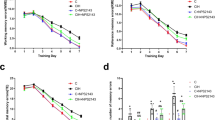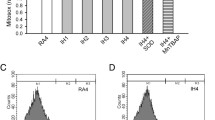Abstract
Obstructive sleep apnea hypopnea syndrome (OSAHS) is associated with the neurocognitive deficits as a result of the neuronal cell injury. Previous studies have shown that adenosine A1 receptor (ADORA1) played an important role against hypoxia exposure, such as controlling the metabolic recovery in rat hippocampal slices and increasing the resistance in the combined effects of hypoxia and hypercapnia. However, little is known about whether ADORA1 takes part in the course of neuronal cell injury after intermittent hypoxia exposure which was the main pathological characteristic of OSAHS. The present study is performed to explore the underlying mechanism of neuronal cell injury which was induced by intermittent hypoxia exposure in PC12 cells. In our research, we find that the stimulation of the ADORA1 by CCPA accelerated the injury of PC12 cells as well as upregulated the expression of PKC, inwardly rectifying potassium channel 6.2(Kir6.2) and sulfonylurea receptor 1(SUR1) while inhibition of the ADORA1 by DPCPX alleviated the injury of PC12 cells as well as downregulated the expression of PKC, Kir6.2, and SUR1. Moreover, inhibition of the PKC by CHE, also mitigated the injury of PC12 cells, suppressed the Kir6.2 and SUR1 expressions induced by PKC. Taken together, our findings indicate that ADORA1 accelerated PC12 cells injury after intermittent hypoxia exposure via ADORA1/PKC/KATP signaling pathway.




Similar content being viewed by others
Abbreviations
- ADORA1:
-
Adenosine A1 receptor
- PKC:
-
Protein kinase C
- KATP :
-
ATP-sensitive potassium channel
- OSAHS:
-
Obstructive sleep apnea hypopnea syndrome
- CCPA:
-
2-Chloro-N6-cyclopentyladenosine
- DPCPX:
-
8-Cyclopentyl-1, 3-dipropylxanthine
- CHE:
-
Chelerythrine chloride
- Kir:
-
Inwardly rectifying potassium channel
- SUR:
-
Sulfonylurea receptor
- IH:
-
Intermittent hypoxia
- SH:
-
Sustained hypoxia
- AC:
-
Air control
- CCK:
-
Cell Counting Kit
References
Toraldo DM, F Nuccio De, M Benedetto De, Scoditti E (2015) Obstructive sleep apnoea syndrome: a new paradigm by chronic nocturnal intermittent hypoxia and sleep disruption. Acta Otorhinolaryngologica Italica. 35(2):69–74
Hopps E, Caimi G (2015) Obstructive sleep apnea syndrome: links betwen pathophysiology and cardiovascular complications. Clin Invest Med 38(6):E362–E370
Damiani MF, Zito A, Carratu P, Falcone VA, Bega E, Scicchitano P, Ciccone MM, Resta O (2015) Obstructive sleep apnea, hypertension, and their additive effects on atherosclerosis. Biochem Res Int. https://doi.org/10.1155/2015/984193
Jianyong L, Jianbin L, Menglin L, Yue X, Qi Y, Yifang Y, Yan Y, Jingying Y (2015) Continuous positive airway pressure treatment for functional cardiac arrhythmias combined with obstructive sleep apnea hypopnea syndrome. Zhonghua er bi yan hou tou jing wai ke za zhi = Chin J Otorhinolaryngol Head Neck Surg 50(3):221–224
Kim Y, Koo YS, Lee HY, Lee SY (2016) Can continuous positive airway pressure reduce the risk of stroke in obstructive sleep apnea patients? a systematic review and meta-analysis. PloS ONE 11(1):e0146317. https://doi.org/10.1371/journal.pone.0146317
Urry E, Landolt HP (2015) Adenosine, caffeine, and performance: from cognitive neuroscience of sleep to sleep pharmacogenetics. Curr Topics Behav Neurosci 25:331–366. https://doi.org/10.1007/7854_2014_274
Eltzschig HK, Bonney SK, Eckle T (2013) Attenuating myocardial ischemia by targeting A2B adenosine receptors. Trends Mol Med 19(6):345–354. https://doi.org/10.1016/j.molmed.2013.02.005
Karmouty-Quintana H, Xia Y, Blackburn MR (2013) Adenosine signaling during acute and chronic disease states. J Mol Med 91(2):173–181. https://doi.org/10.1007/s00109-013-0997-1
Eltzschig HK, Eckle T (2011) Ischemia and reperfusion–from mechanism to translation. Nat Med 17(11):1391–1401. https://doi.org/10.1038/nm.2507
Daniele S, Zappelli E, Natali L, Martini C, Trincavelli ML (2014) Modulation of A1 and A2B adenosine receptor activity: a new strategy to sensitise glioblastoma stem cells to chemotherapy. Cell Death Dis 5:e1539. https://doi.org/10.1038/cddis.2014.487
Sheng H, Li P, Chen X, Liu B, Zhu Z, Cao W (2014) Omega-3 PUFAs induce apoptosis of gastric cancer cells via ADORA1. Front Biosci 19:854–861
Giunta S, Andriolo V, Castorina A (2014) Dual blockade of the A1 and A2A adenosine receptor prevents amyloid beta toxicity in neuroblastoma cells exposed to aluminum chloride. Int J Biochem Cell Biol 54:122–136. https://doi.org/10.1016/j.biocel.2014.07.009
Steinberg SF (2012) Cardiac actions of protein kinase C isoforms. Physiology 27(3):130–139. https://doi.org/10.1152/physiol.00009.2012
Xiao D, Zhu R, Zhang L (2014) Gestational hypoxia up-regulates protein kinase C and inhibits calcium-activated potassium channels in ovine uterine arteries. Int J Med Sci 11(9):886–892. https://doi.org/10.7150/ijms.9338
Shi Y, Wang C, Han S, Pang B, Zhang N, Wang J, Li J (2012) Determination of PKC isoform-specific protein expression in pulmonary arteries of rats with chronic hypoxia-induced pulmonary hypertension. Med Sci Monit 18(2):BR69-75
Ansari HR, Teng B, Nadeem A, Roush KP, Martin KH, Schnermann J, Mustafa SJ (2009) A1 adenosine receptor-mediated PKC and p42/p44 MAPK signaling in mouse coronary artery smooth muscle cells. Am J Physiol Heart Circ Physiol 297(3):H1032–H1039. https://doi.org/10.1152/ajpheart.00374.2009
Aziz Q, Thomas AM, Khambra T, Tinker A (2012) Regulation of the ATP-sensitive potassium channel subunit, Kir6.2, by a Ca2+-dependent protein kinase C. J Biol Chem 287(9):6196–6207. https://doi.org/10.1074/jbc.M111.243923
Isomoto S, Kurachi Y (1997) Function, regulation, pharmacology, and molecular structure of ATP-sensitive K+ channels in the cardiovascular system. J Cardiovasc Electrophysiol 8(12):1431–1446
Ashcroft FM, Gribble FM (2000) New windows on the mechanism of action of K(ATP) channel openers. Trends Pharmacol Sci 21(11):439–445
Zoga V, Kawano T, Liang MY, Bienengraeber M, Weihrauch D, McCallum B, Gemes G, Hogan Q, Sarantopoulos C (2010) KATP channel subunits in rat dorsal root ganglia: alterations by painful axotomy. Mol Pain 6:6. https://doi.org/10.1186/1744-8069-6-6
Sun HS, Xu B, Chen W, Xiao A, Turlova E, Alibraham A, Barszczyk A, Bae CY, Quan Y, Liu B, Pei L, Sun CL, Deurloo M, Feng ZP (2015) Neuronal K(ATP) channels mediate hypoxic preconditioning and reduce subsequent neonatal hypoxic-ischemic brain injury. Exp Neurol 263:161–171. https://doi.org/10.1016/j.expneurol.2014.10.003
Qu YY, Yuan MY, Liu Y, Xiao XJ, Zhu YL (2015) The protective effect of epoxyeicosatrienoic acids on cerebral ischemia/reperfusion injury is associated with PI3K/Akt pathway and ATP-sensitive potassium channels. Neurochem Res 40(1):1–14. https://doi.org/10.1007/s11064-014-1456-2
Li RC, Haribabu B, Mathis SP, Kim J, Gozal D (2011) Leukotriene B4 receptor-1 mediates intermittent hypoxia-induced atherogenesis. Am J Resp Crit Care Med 184(1):124–131. https://doi.org/10.1164/rccm.201012-2039OC
Nair D, Dayyat EA, Zhang SX, Wang Y, Gozal D (2011) Intermittent hypoxia-induced cognitive deficits are mediated by NADPH oxidase activity in a murine model of sleep apnea. PloS ONE 6(5):e19847. https://doi.org/10.1371/journal.pone.0019847
Tsapikouni T, Garreta E, Melo E, Navajas D, Farre R (2012) A bioreactor for subjecting cultured cells to fast-rate intermittent hypoxia. Resp Physiol Neurobiol 182(1):47–52. https://doi.org/10.1016/j.resp.2012.01.001
Kim H, Na YR, Kim SY, Yang EG (2016) Protein kinase C isoforms differentially regulate hypoxia-inducible factor-1alpha accumulation in cancer cells. J Cell Biochem 117(3):647–658. https://doi.org/10.1002/jcb.25314
Waza AA, Andrabi K, Hussain MU (2014) Protein kinase C (PKC) mediated interaction between conexin43 (Cx43) and K(+)(ATP) channel subunit (Kir6.1) in cardiomyocyte mitochondria: Implications in cytoprotection against hypoxia induced cell apoptosis. Cell Signal 26(9):1909–1917. https://doi.org/10.1016/j.cellsig.2014.05.002
Ma YC, Huang LJ, Zheng MX, Wang YY, Ying L, Wang WT (2014) Expression of KATP in pulmonary artery smooth muscle cells under hypoxia-hypercapnia condition and the relationship with p38 MAPK pathway. Sheng li xue bao 66 (3):283–288
Zhang W, Carreno FR, Cunningham JT, Mifflin SW (2008) Chronic sustained and intermittent hypoxia reduce function of ATP-sensitive potassium channels in nucleus of the solitary tract. Am J Physiol Regulat Integr Compar Physiol 295(5):R1555–R1562. https://doi.org/10.1152/ajpregu.90390.2008
Cai XH, Li XC, Jin SW, Liang DS, Wen ZW, Cao HC, Mei HF, Wu Y, Lin ZD, Wang LX (2014) Endoplasmic reticulum stress plays critical role in brain damage after chronic intermittent hypoxia in growing rats. Exp Neurol 257:148–156. https://doi.org/10.1016/j.expneurol.2014.04.029
Fung SJ, Xi M, Zhang J, Sampogna S, Chase MH (2012) Apnea produces excitotoxic hippocampal synapses and neuronal apoptosis. Exp Neurol 238(2):107–113. https://doi.org/10.1016/j.expneurol.2012.08.006
Hirsch Allen AJ, Bansback N, Ayas NT (2015) The effect of OSA on work disability and work-related injuries. Chest 147(5):1422–1428. https://doi.org/10.1378/chest.14-1949
Gozal D, Daniel JM, Dohanich GP (2001) Behavioral and anatomical correlates of chronic episodic hypoxia during sleep in the rat. J Neurosci 21(7):2442–2450
Multani PK, Hodge R, Estevez MA, Abel T, Kung H, Alter M, Brookshire B, Lucki I, Nall AH, Talbot K, Doyle GA, Lohoff FW (2013) VMAT1 deletion causes neuronal loss in the hippocampus and neurocognitive deficits in spatial discrimination. Neuroscience 232:32–44. https://doi.org/10.1016/j.neuroscience.2012.11.023
Fredholm BB (2007) Adenosine, an endogenous distress signal, modulates tissue damage and repair. Cell Death Differ 14(7):1315–1323. https://doi.org/10.1038/sj.cdd.4402132
Takahashi T, Otsuguro K, Ohta T, Ito S (2010) Adenosine and inosine release during hypoxia in the isolated spinal cord of neonatal rats. Br J Pharmacol 161(8):1806–1816. https://doi.org/10.1111/j.1476-5381.2010.01002.x
Zimmermann H (2000) Extracellular metabolism of ATP and other nucleotides. Naunyn-Schmiedeberg’s Archiv Pharmacol 362(4–5):299–309
McGaraughty S, Cowart M, Jarvis MF, Berman RF (2005) Anticonvulsant and antinociceptive actions of novel adenosine kinase inhibitors. Curr Topics Med Chem 5(1):43–58
Fredholm BB (2010) Adenosine receptors as drug targets. Exp Cell Res 316(8):1284–1288. https://doi.org/10.1016/j.yexcr.2010.02.004
Babich V, Vadnagara K, Di Sole F (2015) Dual effect of Adenosine A1 receptor activation on renal O2 consumption. J Cell Physiol 230(12):3093–3104. https://doi.org/10.1002/jcp.25050
Sun MK, Xu H, Alkon DL (2002) Pharmacological protection of synaptic function, spatial learning, and memory from transient hypoxia in rats. J Pharmacol Exp Ther 300(2):408–416
zur Nedden S, Hawley S, Pentland N, Hardie DG, Doney AS, Frenguelli BG (2011) Intracellular ATP influences synaptic plasticity in area CA1 of rat hippocampus via metabolism to adenosine and activity-dependent activation of adenosine A1 receptors. J Neurosci 31(16):6221–6234
Martelli AM, Sang N, Borgatti P, Capitani S, Neri LM (1999) Multiple biological responses activated by nuclear protein kinase C. J Cell Biochem 74(4):499–521
Toker A (1998) Signaling through protein kinase C. Front Biosci. 3:D1134–D1147
Marala RB, Mustafa SJ (1995) Adenosine A1 receptor-induced upregulation of protein kinase C: role of pertussis toxin-sensitive G protein(s). Am J Physiol 269(5 Pt 2):H1619–H1624
Marala RB, Mustafa SJ (1995) Adenosine analogues prevent phorbol ester-induced PKC depletion in porcine coronary artery via A1 receptor. Am J Physiol 268(1 Pt 2):H271–H277
Robin E, Sabourin J, Benoit R, Pedretti S, Raddatz E (2011) Adenosine A1 receptor activation is arrhythmogenic in the developing heart through NADPH oxidase/ERK- and PLC/PKC-dependent mechanisms. J Mol Cell Cardiol 51(6):945–954. https://doi.org/10.1016/j.yjmcc.2011.08.023
Fredholm BB, AP IJ, Jacobson KA, Klotz KN, Linden J (2001) International union of pharmacology. XXV. Nomenclature and classification of adenosine receptors. Pharmacol Rev 53(4):527–552
Miao Q, Wang S, Miao S, Wang J, Xie Y, Yang Q (2011) Cardioprotective effect of polydatin against ischemia/reperfusion injury: roles of protein kinase C and mito K(ATP) activation. Phytomedicine 19(1):8–12. https://doi.org/10.1016/j.phymed.2011.06.023
Geiseler SJ, Ludvigsen S, Folkow LP (2015) KATP-channels play a minor role in the protective hypoxic shut-down of cerebellar activity in eider ducks (Somateria mollissima). Neuroscience 284:751–758. https://doi.org/10.1016/j.neuroscience.2014.10.046
Gupta S, Sharma B (2014) Protective effects of phosphodiesterase-1 (PDE1) and ATP sensitive potassium (KATP) channel modulators against 3-nitropropionic acid induced behavioral and biochemical toxicities in experimental Huntingtons disease. Eur J Pharmacol 732:111–122. https://doi.org/10.1016/j.ejphar.2014.03.032
Wang L, Zhu QL, Wang GZ, Deng TZ, Chen R, Liu MH, Wang SW (2011) The protective roles of mitochondrial ATP-sensitive potassium channels during hypoxia-ischemia-reperfusion in brain. Neurosci Lett 491(1):63–67. https://doi.org/10.1016/j.neulet.2010.12.065
Janse MJ, Wit AL (1989) Electrophysiological mechanisms of ventricular arrhythmias resulting from myocardial ischemia and infarction. Physiol Rev 69(4):1049–1169
Wilde AA (1993) Role of ATP-sensitive K+ channel current in ischemic arrhythmias. Cardiovasc Drugs Ther 7(3):521–526
Yamada K, Ji JJ, Yuan H, Miki T, Sato S, Horimoto N, Shimizu T, Seino S, Inagaki N (2001) Protective role of ATP-sensitive potassium channels in hypoxia-induced generalized seizure. Science 292(5521):1543–1546. https://doi.org/10.1126/science.1059829
Acknowledgements
This work was supported by Zhejiang Provincial Natural Science Foundation Grant (LY17H010004), Scientific Research Foundation of Health Bureau of Zhejiang Province (2018ZD010), Wenzhou City Science and Technology Bureau Grant (Y20170133), National Science-technology Support Program (2015BAI12B09), and Project of Key Innovative Disciplines of Children Sleep Medicine of Zhejiang.
Author information
Authors and Affiliations
Corresponding authors
Ethics declarations
Conflict of interest
The authors confirm that the content of this article has no conflicts of interest.
Rights and permissions
About this article
Cite this article
Mei, HF., Poonit, N., Zhang, YC. et al. Activating adenosine A1 receptor accelerates PC12 cell injury via ADORA1/PKC/KATP pathway after intermittent hypoxia exposure. Mol Cell Biochem 446, 161–170 (2018). https://doi.org/10.1007/s11010-018-3283-2
Received:
Accepted:
Published:
Issue Date:
DOI: https://doi.org/10.1007/s11010-018-3283-2




